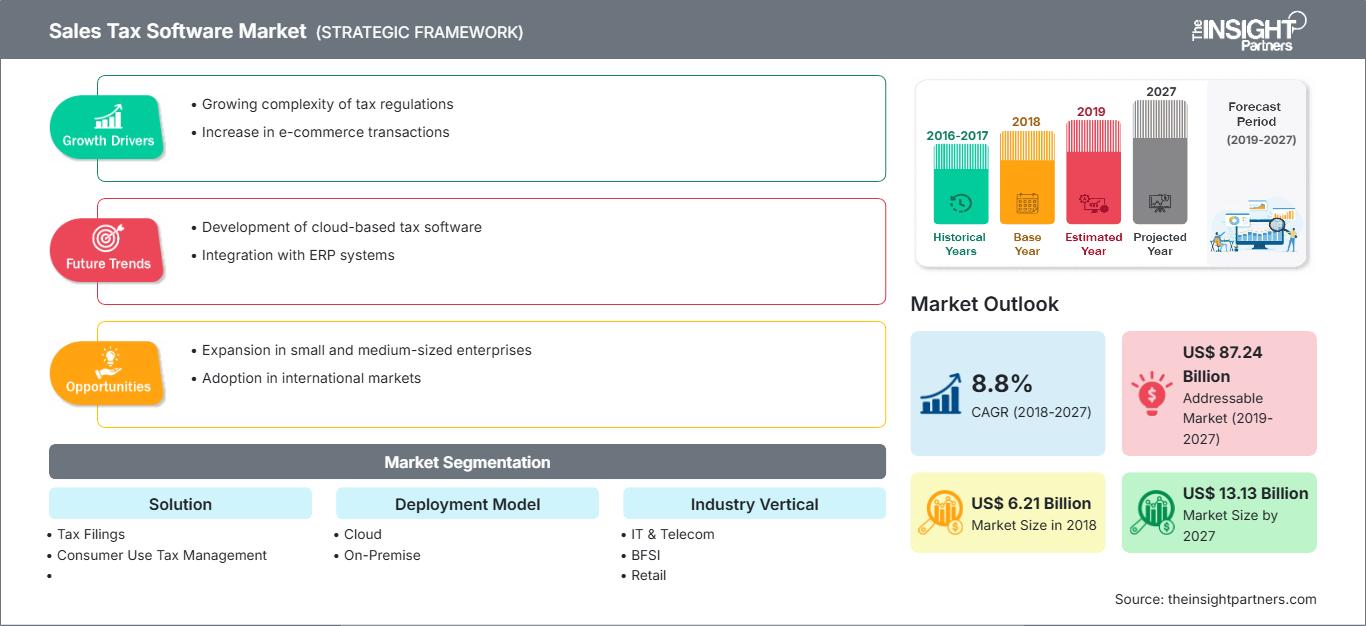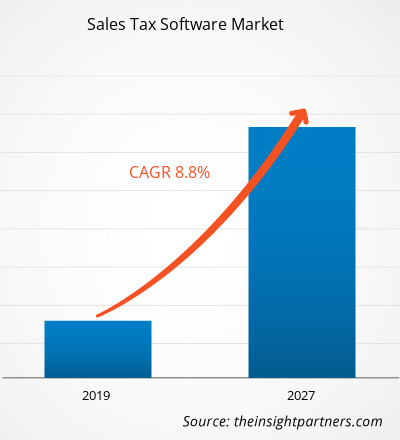[Forschungsbericht]Der Markt für Umsatzsteuersoftware belief sich 2018 auf 6,21 Mrd. USD und soll im Prognosezeitraum 2019–2027 mit einer durchschnittlichen jährlichen Wachstumsrate von 8,8 % wachsen und bis 2027 13,13 Mrd. USD erreichen.
Unter den verschiedenen geografischen Regionen war Nordamerika der führende Markt für Umsatzsteuersoftware und wird voraussichtlich im gesamten Prognosezeitraum den höchsten Umsatzbeitrag leisten. Das Wachstum und die Akzeptanz des nordamerikanischen Marktes für Umsatzsteuersoftware werden hauptsächlich durch die steigende Nachfrage nach Umsatzsteuersoftware aus verschiedenen Branchen wie Einzelhandel, IT & Telekommunikation, Transport und Gesundheitswesen vorangetrieben.
Markteinblicke: Fokus auf die ständige Aktualisierung der Steuergesetze und -vorschriften weltweit
Umsatzsteuer und indirekte Steuern sind wichtige Einnahmequellen für Regierungen, und effiziente sowie ausgeklügelte Steuergesetze helfen den Behörden, maximale Steuereinnahmen zu erzielen. Mit dem zunehmenden grenzüberschreitenden Handel und Online-Einzelhandel weltweit sowie neuesten Trends wie E-Commerce und Digitalisierung aktualisieren Steuerbehörden weltweit ihre Steuergesetze und -vorschriften ständig, um diesen aktuellen Entwicklungen auf den globalen Märkten Rechnung zu tragen. Die Auswirkungen von Änderungen der Steuergesetze und -vorschriften sind ungewiss und hängen von zahlreichen Faktoren ab. Unternehmen müssen daher erhebliche Ressourcen investieren, um ihre Umsatzsteuerberechnungen zu verstehen und weiterzuentwickeln. Durch die Beteiligung von Menschen besteht ein hohes Risiko, wichtige Details zu übersehen, was zu Berechnungsfehlern und Strafen durch die Behörden führen kann. Große Unternehmen haben diese Notwendigkeit erkannt und investieren in die Automatisierung der Umsatzsteuerberechnung und des Einreichungsprozesses, um das Risiko menschlicher Fehler zu reduzieren. Kleine und mittlere Unternehmen sind jedoch noch dabei, sich an die Idee der Automatisierung und Digitalisierung anzupassen. Daher wird erwartet, dass sich ständig ändernde Steuergesetze und -vorschriften das zukünftige Wachstum des Marktes für Umsatzsteuersoftware vorantreiben.
Passen Sie diesen Bericht Ihren Anforderungen an
Sie erhalten kostenlos Anpassungen an jedem Bericht, einschließlich Teilen dieses Berichts oder einer Analyse auf Länderebene, eines Excel-Datenpakets sowie tolle Angebote und Rabatte für Start-ups und Universitäten.
Markt für Umsatzsteuersoftware: Strategische Einblicke

-
Holen Sie sich die wichtigsten Markttrends aus diesem Bericht.Dieses KOSTENLOSE Beispiel umfasst Datenanalysen, die von Markttrends bis hin zu Schätzungen und Prognosen reichen.
Die weltweite Digitalisierung bietet Unternehmen enorme Chancen, digitale Dienste und Automatisierung zu nutzen, um ihre Geschäftsmodelle und bestehenden Prozesse zu transformieren und so die betriebliche Effizienz und den Umsatz zu steigern. Die digitale Transformation oder Digitalisierung von Unternehmen umfasst im Wesentlichen die Integration digitaler Technologien in verschiedene Geschäftsprozesse, organisatorische Aktivitäten und Geschäftsmodelle. Die Optimierung von Geschäftsprozessen von Anfang bis Ende, die Steigerung der betrieblichen Effizienz sowie die Reduzierung von Kosten und menschlichen Fehlern sind einige der wichtigsten Treiber der digitalen Transformation in jeder Branche. Der Paradigmenwechsel von traditionellen zu digitalen und automatisierten Prozessen hat den Unternehmen zahlreiche Vorteile gebracht, von verbesserter Effizienz über geringere Kosten bis hin zu höheren Umsatzchancen. Darüber hinaus hat sich die Leistungsfähigkeit cloudbasierter Plattformen im letzten Jahrzehnt durch die technologischen Fortschritte im Cloud-Computing und in der Speichertechnologie vervielfacht. Dies eröffnet Unternehmen neue Möglichkeiten, sich für cloudbasierte Umsatzsteuersoftware zu entscheiden.
Komponenteneinblicke
Der globale Markt für Umsatzsteuersoftware wurde nach Komponenten vom Segment Lösungen zur Steuerermittlung und -abgabe angeführt. Lösungen zur Verwaltung von Compliance-Dokumenten hatten 2018 den zweitgrößten Anteil am Markt für Umsatzsteuersoftware, und dieser Anteil dürfte im Prognosezeitraum von 2019 bis 2027 noch weiter steigen.
Einblicke in die Bereitstellungsart
Der globale Markt für Umsatzsteuersoftware wurde nach Bereitstellungsart vom Cloud-Segment angeführt. Unternehmen tendieren eher zu cloudbasierter Umsatzsteuersoftware, da die Steuererklärung automatisch auf sicheren Servern gesichert wird. Cloudfähige Software ermöglicht Unternehmen eine schnelle Expansion ohne erhebliche Investitionen in ihre Technologieinfrastruktur, da Cloud-Technologien sich enorm an beschleunigte Veränderungen anpassen. Sie sind anpassungsfähig an dynamische Regulierungs- und Berichtsumgebungen.
Einblicke in Branchenvertikale
Der globale Markt für Umsatzsteuersoftware ist nach Branchenvertikalen segmentiert, wie z. B. BFSI, Einzelhandel, IT & Telekommunikation, Transport, Gesundheitswesen und andere. Im Jahr 2018 hatte der Einzelhandel den größten Umsatzanteil am globalen Markt für Umsatzsteuersoftware und dürfte seine beherrschende Stellung im Prognosezeitraum von 2019 bis 2027 beibehalten. 2027. Zu den weiteren Endnutzern des Umsatzsteuersoftwaremarkts zählen Energie, Fertigung, Bildung und Gastgewerbe.
Die Marktteilnehmer auf dem Markt für Umsatzsteuersoftware konzentrieren sich hauptsächlich auf Produktverbesserungen durch die Implementierung fortschrittlicher Technologien. Durch die Unterzeichnung von Partnerschaften, Verträgen, Joint Ventures, Finanzierungen und die Eröffnung neuer Niederlassungen auf der ganzen Welt kann das Unternehmen seinen Markennamen global aufrechterhalten. Einige der jüngsten Entwicklungen auf dem globalen Markt für Umsatzsteuersoftware sind unten aufgeführt:
2019: Sovos Compliance und Tytho unterzeichneten eine strategische Partnerschaftsvereinbarung, um die Führungsposition im Steuerbereich zu stärken, die Implementierung von Sovos Compliance-Lösungen zu unterstützen und das Produkt zu bewerben. 2017: TaxJar schloss in der Serie-A-Finanzierungsrunde 60 Millionen US-Dollar von Insight Venture Partners ab. Die jüngste Finanzierung in Höhe von 2 Mio. US-Dollar wurde 2014 von Rincon Venture Partners und Daher Capital geleitet. Die Finanzierung würde es dem Unternehmen ermöglichen, sich auf Produktentwicklung und Geschäftsentwicklungsstrategien zu konzentrieren. 2018: Ryan erweiterte den Umfang der Allianz mit Avalara, um Beratungsdienste für Kraftstoffunternehmen anzubieten, die ihr ERP-System wechseln möchten, um eine effiziente Steuerermittlung und -berichterstattung zu erreichen.
Umsatzsteuersoftware
Regionale Einblicke in den Markt für UmsatzsteuersoftwareDie Analysten von The Insight Partners haben die regionalen Trends und Faktoren, die den Markt für Umsatzsteuersoftware im Prognosezeitraum beeinflussen, ausführlich erläutert. In diesem Abschnitt werden auch die Marktsegmente und die geografische Lage in Nordamerika, Europa, dem asiatisch-pazifischen Raum, dem Nahen Osten und Afrika sowie Süd- und Mittelamerika erörtert.
Umfang des Marktberichts zur Umsatzsteuersoftware
| Berichtsattribut | Einzelheiten |
|---|---|
| Marktgröße in 2018 | US$ 6.21 Billion |
| Marktgröße nach 2027 | US$ 13.13 Billion |
| Globale CAGR (2018 - 2027) | 8.8% |
| Historische Daten | 2016-2017 |
| Prognosezeitraum | 2019-2027 |
| Abgedeckte Segmente |
By Lösung
|
| Abgedeckte Regionen und Länder |
Nordamerika
|
| Marktführer und wichtige Unternehmensprofile |
|
Dichte der Marktteilnehmer im Bereich Umsatzsteuersoftware: Auswirkungen auf die Geschäftsdynamik verstehen
Der Markt für Umsatzsteuersoftware wächst rasant. Dies wird durch die steigende Nachfrage der Endnutzer aufgrund veränderter Verbraucherpräferenzen, technologischer Fortschritte und eines stärkeren Bewusstseins für die Produktvorteile vorangetrieben. Mit der steigenden Nachfrage erweitern Unternehmen ihr Angebot, entwickeln Innovationen, um den Bedürfnissen der Verbraucher gerecht zu werden, und nutzen neue Trends, was das Marktwachstum weiter ankurbelt.

- Holen Sie sich die Markt für Umsatzsteuersoftware Übersicht der wichtigsten Akteure
- Steuerermittlung & Ablagelösungen
- Lösungen für Compliance-Dokumentenmanagement
- Services
Nach Bereitstellungstyp
- Cloud
- On-Premise
Nach Branche
- BFSI
- IT und Telekommunikation
- Einzelhandel
- Gesundheitswesen
- Transport
- Sonstige
Nach Geografie
-
Nordamerika
- USA
- Kanada
- Mexiko
-
Europa
- Frankreich
- Deutschland
- Großbritannien
- Russland
- Italien
- Restliches Europa
-
Asien-Pazifik (APAC)
- Südkorea
- China
- Indien
- Japan
- Australien
- Rest von APAC
-
Naher Osten und Afrika (MEA)
- Saudi-Arabien
- Südafrika
- VAE
- Rest von MEA
-
Südamerika (SAM)
- Brasilien
- Argentinien
- Rest von SAM
Unternehmensprofile
- APEX Analytix
- Avalara, Inc.
- Ryan, LLC
- The Sage Group Plc
- Sovos Compliance LLC
- Historische Analyse (2 Jahre), Basisjahr, Prognose (7 Jahre) mit CAGR
- PEST- und SWOT-Analyse
- Marktgröße Wert/Volumen – Global, Regional, Land
- Branchen- und Wettbewerbslandschaft
- Excel-Datensatz
Aktuelle Berichte
Verwandte Berichte
Erfahrungsberichte
Grund zum Kauf
- Fundierte Entscheidungsfindung
- Marktdynamik verstehen
- Wettbewerbsanalyse
- Kundeneinblicke
- Marktprognosen
- Risikominimierung
- Strategische Planung
- Investitionsbegründung
- Identifizierung neuer Märkte
- Verbesserung von Marketingstrategien
- Steigerung der Betriebseffizienz
- Anpassung an regulatorische Trends






















 Kostenlose Probe anfordern für - Markt für Umsatzsteuersoftware
Kostenlose Probe anfordern für - Markt für Umsatzsteuersoftware